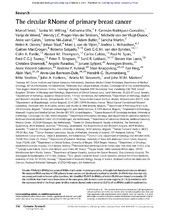| dc.contributor.author | Smid, Marcel | en_US |
| dc.contributor.author | Wilting, Saskia M. | en_US |
| dc.contributor.author | Uhr, Katharina | en_US |
| dc.contributor.author | Rodríguez-González, F. Germán | en_US |
| dc.contributor.author | de Weerd, Vanja | en_US |
| dc.contributor.author | Prager-Van der Smissen, Wendy J.C. | en_US |
| dc.contributor.author | van der Vlugt-Daane, Michelle | en_US |
| dc.contributor.author | van Galen, Anne | en_US |
| dc.contributor.author | Nik-Zainal, Serena | en_US |
| dc.contributor.author | Butler, Adam | en_US |
| dc.contributor.author | Martin, Sancha | en_US |
| dc.contributor.author | Davies, Helen R. | en_US |
| dc.contributor.author | Staaf, Johan | en_US |
| dc.contributor.author | van de Vijver, Marc J. | en_US |
| dc.contributor.author | Richardson, Andrea L. | en_US |
| dc.contributor.author | Macgrogan, Gaëtan | en_US |
| dc.contributor.author | Salgado, Roberto | en_US |
| dc.contributor.author | van den Eynden, Gert G.G.M. | en_US |
| dc.contributor.author | Purdie, Colin A. | en_US |
| dc.contributor.author | Thompson, Alastair M. | en_US |
| dc.contributor.author | Caldas, Carlos | en_US |
| dc.contributor.author | Span, Paul N. | en_US |
| dc.contributor.author | Sweep, Fred C.G.J. | en_US |
| dc.contributor.author | Simpson, Peter T. | en_US |
| dc.contributor.author | Lakhani, Sunil R. | en_US |
| dc.contributor.author | Van Laere, Steven | en_US |
| dc.contributor.author | Desmedt, Christine | en_US |
| dc.contributor.author | Paradiso, Angelo | en_US |
| dc.contributor.author | Eyfjord, Jorunn | en_US |
| dc.contributor.author | Broeks, Annegien | en_US |
| dc.contributor.author | Vincent-Salomon, Anne | en_US |
| dc.contributor.author | Futreal, Andrew P. | en_US |
| dc.contributor.author | Knappskog, Stian | en_US |
| dc.contributor.author | King, Tari | en_US |
| dc.contributor.author | Viari, Alain | en_US |
| dc.contributor.author | Børresen-Dale, Anne-Lise | en_US |
| dc.contributor.author | Stunnenberg, Hendrik G. | en_US |
| dc.contributor.author | Stratton, Mike | en_US |
| dc.contributor.author | Foekens, John A. | en_US |
| dc.contributor.author | Sieuwerts, Anieta M. | en_US |
| dc.contributor.author | Martens, John W.M. | en_US |
| dc.date.accessioned | 2020-04-22T11:03:43Z | |
| dc.date.available | 2020-04-22T11:03:43Z | |
| dc.date.issued | 2019 | |
| dc.Published | Smid M, Wilting SM, Uhr, Rodríguez-González FG, de Weerd, Prager-Van der Smissen, van der Vlugt-Daane, van Galen, Nik-Zainal S, Butler A, Martin S, Davies HR, Staaf J, van de Vijver MJ, Richardson AL, Macgrogan G, Salgado R, van den Eynden, Purdie CA, Thompson AM, Caldas C, Span PN, Sweep FC, Simpson PT, Lakhani SR, Van Laere S, Desmedt C, Paradiso A, Eyfjord J, Broeks A, Vincent-Salomon A, Futreal, Knappskog S, King T, Viari A, Børresen-Dale A, Stunnenberg HG, Stratton M, Foekens JA, Sieuwerts AM, Martens JW. The circular RNome of primary breast cancer. Genome Research. 2019;29(3):356-366 | eng |
| dc.identifier.issn | 1549-5469 | |
| dc.identifier.issn | 1088-9051 | |
| dc.identifier.uri | https://hdl.handle.net/1956/21968 | |
| dc.description.abstract | Circular RNAs (circRNAs) are a class of RNAs that is under increasing scrutiny, although their functional roles are debated. We analyzed RNA-seq data of 348 primary breast cancers and developed a method to identify circRNAs that does not rely on unmapped reads or known splice junctions. We identified 95,843 circRNAs, of which 20,441 were found recurrently. Of the circRNAs that match exon boundaries of the same gene, 668 showed a poor or even negative (R < 0.2) correlation with the expression level of the linear gene. In silico analysis showed only a minority (8.5%) of circRNAs could be explained by known splicing events. Both these observations suggest that specific regulatory processes for circRNAs exist. We confirmed the presence of circRNAs of CNOT2, CREBBP, and RERE in an independent pool of primary breast cancers. We identified circRNA profiles associated with subgroups of breast cancers and with biological and clinical features, such as amount of tumor lymphocytic infiltrate and proliferation index. siRNA-mediated knockdown of circCNOT2 was shown to significantly reduce viability of the breast cancer cell lines MCF-7 and BT-474, further underlining the biological relevance of circRNAs. Furthermore, we found that circular, and not linear, CNOT2 levels are predictive for progression-free survival time to aromatase inhibitor (AI) therapy in advanced breast cancer patients, and found that circCNOT2 is detectable in cell-free RNA from plasma. We showed that circRNAs are abundantly present, show characteristics of being specifically regulated, are associated with clinical and biological properties, and thus are relevant in breast cancer. | en_US |
| dc.language.iso | eng | eng |
| dc.publisher | CSH Press | eng |
| dc.rights | Attribution CC BY-NC | eng |
| dc.rights.uri | http://creativecommons.org/licenses/by-nc/4.0/ | eng |
| dc.title | The circular RNome of primary breast cancer | en_US |
| dc.type | Peer reviewed | |
| dc.type | Journal article | |
| dc.date.updated | 2019-12-27T11:02:19Z | |
| dc.description.version | publishedVersion | en_US |
| dc.rights.holder | Copyright 2019 The Author(s) | |
| dc.identifier.doi | https://doi.org/10.1101/gr.238121.118 | |
| dc.identifier.cristin | 1704742 | |
| dc.source.journal | Genome Research | |

